Together with the Technical University of Berlin, the Audi Foundation for the Environment has developed filters for road runoff. They prevent tire abrasion and other environmentally harmful particles from being flushed into sewers and bodies of water along with rainwater. Initial practical and laboratory tests are now demonstrating the system’s efficiency.
Tire and road abrasion is produced every time a car is driven. An estimated 110,000 metric tons of this end up on the road every year in Germany alone in the form of microplastics. From there, it disperses into the environment via the wind, or it is washed away by rain via road runoff and sewers into soils, rivers and ultimately the oceans.
“Our goal is to intervene preventively wherever possible and allow fewer microplastics to enter the environment.”
- Rüdiger Recknagel, Managing Director
Together with the Technical University of Berlin (Department of Urban Water Management), the Audi Foundation for the Environment is therefore developing a novel filter concept for street drains. These filters can be individually combined depending on the traffic situation and retain the respective dirt particles as close as possible to the point of origin — even before they are washed into the sewage system by rainwater. The project was launched in September 2020.
Tests in the lab and on the street
Tests in the TU Berlin laboratory showed that the filters work very effectively. They managed to permanently retain “real” street sweepings, cigarette filters, microplastics in the form of plastic granules up to three millimeters in size, candy wrappers or even lids from coffee-to-go cups without clogging. “The system manages to do this not only during light or weak drizzle, but also when it rains really hard,” says Daniel Venghaus, a research associate in the Department of Urban Water Management.
A filter has also been in operation for more than a month on a busy street in Berlin. The urban filter successfully mastered the first stress test in the form of the series of storms in mid-February. It is expected to remain in service until the end of the year. The researchers want to take samples of both the inflow and the outflowing water in order to determine the efficiency in real operation over the course of the seasons. Furthermore, initial discussions are already underway with the ADAC Driving Safety Center Berlin-Brandenburg to install filters on driving routes to gain a better understanding of how abrasion is filtered in different driving situations.
Nine modules for different applications
The sediment filters are divided into three zones: road, manhole and drain, and consist of nine modules. Up to three modules can be combined to achieve the best result depending on the location. In the uppermost street zone, this can be a special drain channel. Below that, in the gully itself, solids are coarsely filtered out, for example, with the aid of an optimized leaf basket or a so-called filter skirt. In the lowest area, the drain, fine filtration is required, for which a magnetic module can be used.
This filtering of the finest particles still poses challenges for the researchers around Daniel Venghaus. “Tests with tire powder from 20 to 1,000 micrometers (µm) in size and light to medium rain have passed the system,” explains Venghaus, “Now we’re working on improving the filter performance in heavy rain as well.” However, he adds, the tire powder used for testing purposes behaves differently from real tire abrasion. Here, practical tests on roads should provide further information.
Intelligent networking leads to success
The aim of the tests and further developments, he says, is for the Urbanfilter to be able to operate in practice for up to a year without needing to be maintained and cleaned. This is where intelligent networking comes into play. A lot of different information flows together for this: the dates of the street cleaning, the traffic volume on the respective street, peak times as well as the weather forecast. But also whether there are many trees along the road or whether dogs are frequently walked. These factors can be used to forecast the degree of soiling of the individual filters and to determine when is the optimum time to empty them. For example, a filter could be emptied preemptively before heavy rains come. “We are in close exchange with other partners, such as the engineering company IAV and other research institutions that are specifically involved in intelligent traffic routing and planning,” says Daniel Venghaus.
Urbanfilter exhibit can be experienced on site
An exhibit will be on display at the Audi Forum Ingolstadt until April 4. The piece will then travel on to Wolfsburg. Venghaus will present his research work at the Phaeno science museum on May 1 as part of the “Meet the Scientist” event series. “We are open to other cooperation partners, both in terms of an exhibition and possible locations,” says the scientist.

















